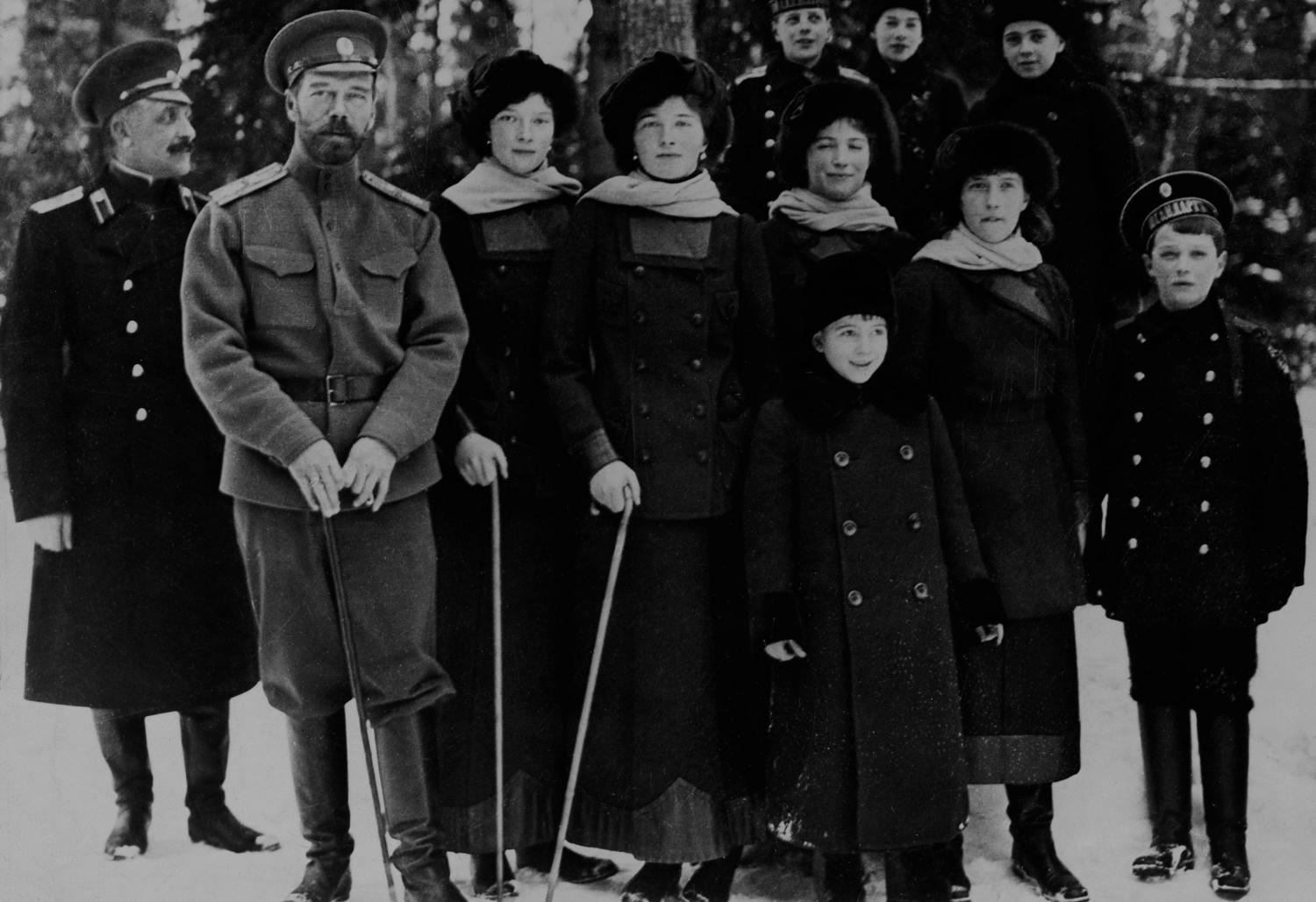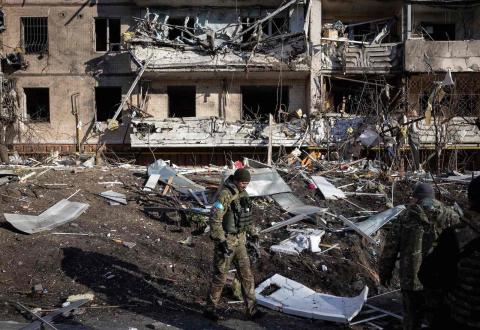A century ago today, Emperor Nicholas II, 'Tsar and Autocrat of all the Russias', pencilled his name to a document renouncing a throne three hundred years in his family's possession, not only for himself but also his son and chronically ill heir, Alexis. The date, according to the old Russian calendar, was 3 March 1917.
So definitively began, after days of riots in war-weary Petrograd, one of the great events of world history: the Russian Revolution. As news of the Tsar's abdication filtered back to the capital, jubilant crowds trampled the Romanovs' double-headed eagle in the streets.
A hundred years later, however, jubilation has yielded to a quieter kind of commemoration. Today, Patriarch Kirill of Moscow will lead a memorial service in honour of Nicholas II and Russia's vanished monarchy.
In 2000, the Russian Orthodox Church recognised Nicholas, his wife and his children as saints, 'holy passion-bearers' venerated for their Christ-like submission to their Bolshevik captors and faith in God, even unto death. For many believers, the last Romanovs have thus become the embodiment of all that is true, Orthodox and Russian – a model of Christian family life in a country with among the highest rates of abortion, divorce and alcoholism in the world.
However, outside the Church (and, sometimes, more quietly, within it), Russia's last emperor remains a divisive subject, posing unresolved questions about the country's past and present.
Take, for example, the controversy that last year enveloped Natalya Poklonskaya, a headline-grabbing member of Russia's State Duma who owes her steely reputation (and her internet fandom) to her dramatic role in Russia's 2014 annexation of Crimea.
A high-ranking official in Ukraine's Ministry of Justice when riots forced former Ukrainian President Viktor Yanukovych from power, Poklonskaya denounced the 'coup', returned home to Crimea, and, as the most senior legal official left in the peninsula, effectively declared Kiev's writ over.
Overnight, the 33-year-old became a household name. Listed as a criminal by the Ukrainian Ministry of Internal Affairs and banned from entering the United States, European Union, Japan and Australia, she was elected to the Russian Duma in 2016.
Even after the upsurge of patriotism that followed events in Crimea, however, the tangled threads of history, memory and identity hang in uneasy tension in contemporary Russia. And Poklonskaya's habit of mingling the symbols of both Russia's Imperial and Soviet past (such as her choice to display an icon of Russia's 'Tsar-Martyr' at last year's Victory Day celebrations) have stirred controversy even among her usual supporters.
Commemorating the Soviet Union's defeat of Nazi Germany in 1945, Victory Day is Russia's de facto national holiday. An occasion for grand military parades in Red Square during Soviet times (and again since President Vladimir Putin's revival of the tradition), the day has recently witnessed the appearance of a new custom.
Known as the march of the Bessmertny Polk (or 'Immortal Regiment'), ordinary Russians parade down the country's main streets, carrying photographs of parents and grandparents who contributed to the war effort. Though the first march was held only in 2012 (and organised independently of the authorities), they've since attracted hundreds of thousands every year, from Kaliningrad to Vladivostok.
In an act that aroused the ire not only of the country's remaining Communists but many ordinary Russians, however, Poklonskaya took part in last year's Moscow parade carrying not a portrait of her ancestors, but an icon of Nicholas II. This reminder of the ancien régime was taken as an insult on a day dedicated to the feats of the Soviet state that overthrew it.
In America and France, the revolutions of 1776 and 1789 serve as the foundation of modern civic patriotism. Not so in Russia, whose citizens approach the centenary of 1917 with a lack of consensus about the meaning of their country's revolution and the Bolshevik dictatorship that resulted by the end of the year.
Though the Bolsheviks played no role in the events of February (which saw Tsar, under pressure from an Army, cede power to a Provisional Government composed of liberals, headed by a member of the aristocracy, Prince Georgy Lvov), they became its chief beneficiaries. Seizing power in October and later renamed as Communists, they would rule most of the former Russian Empire for the next seven decades until 1991 saw the birth of an apparently liberal and democratic Russia under the leadership of President Boris Yeltsin.
When Communism collapsed 25 years ago, many believed 1991 would at last fulfil the hopes of February 1917. Today, however, Russia's 'liberal' 1990s are remembered for industrial and economic collapse, the breakdown of public morality and national humiliation.
For some older Russians, the Soviet period remains a golden age, mixing pride in victory over Nazi Germany with memories of the Socialist-inspired solidarity and material contentment of the days of Brezhnev. For others, however, Putin's 'counter-revolution' has meant rediscovery of Imperial Russia, celebrated in lavish historical exhibitions sponsored by Church and State.
Cautiously, we might call these groups modern Russia's 'Reds' and 'Whites'. Especially since the upsurge of patriotic feeling following the 2014 annexation of Crimea, both have generally rallied to the Kremlin, sustaining Putin's 80% approval rating and presenting the appearance of a solid patriotic front.
As leading conservative commentator Boris Mezhuev has observed, however, the Poklonskaya affair reveals that Russia's apparently monolithic patriotic majority is far from seamlessly united. The union of 'Reds' and 'Whites' around the Kremlin is riven by different attitudes not only to Russia's past but also, implicitly, its future. The task of creating a viable form of contemporary Russian civic patriotism is thus urgent.
That's why, says Mezhuev, for all the controversy Poklonskaya, was right to carry Nicholas's icon. Neither 1917 nor 1991 but 1945 is the founding date of modern Russian self-understanding; however, a reminder is needed that the price of the Soviet Union's victory over Nazism was the lives of millions of its citizens, not only in the blood-soaked annals of World War II, but in the Revolution, Civil War (1918-22) and the repressions, famines and terror of the 1930s.
This is where Nicholas, hailed in hindsight as a leader who chose the path of non-resistance over violent repression for the sake of preserving the nation's unity in its struggle against the enemy, comes in.
Among the first of Communism's many victims, Nicholas II stands as symbol not only of country over self, but for all those sacrificed on the altar of Socialist utopia. Only by acknowledging their contribution can Russians make peace with not only with their past, but their present as well.
Should 1917 be celebrated – or should it be mourned?
For many Russians, the answer has less to do with history than with what kind of a people they are today.

